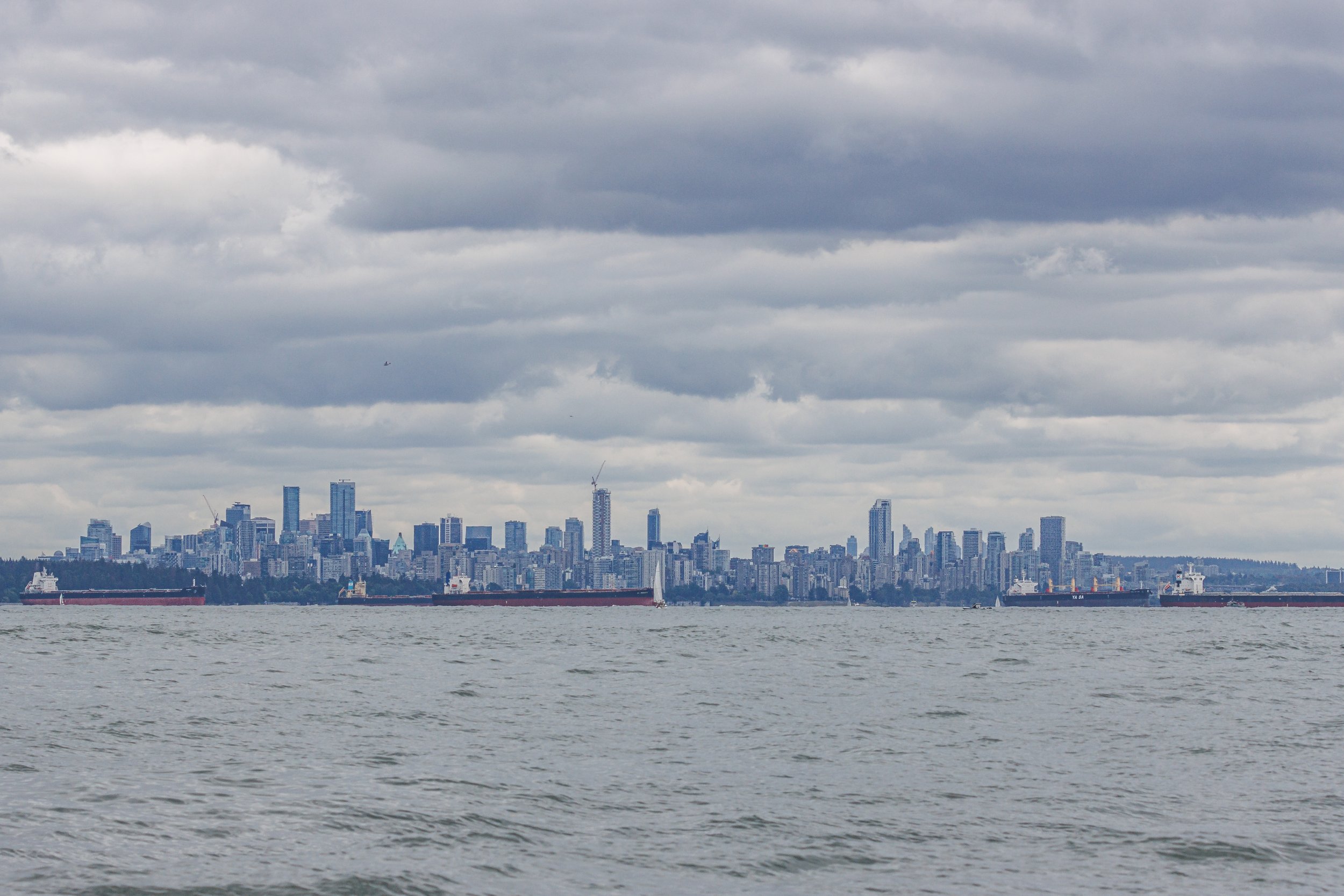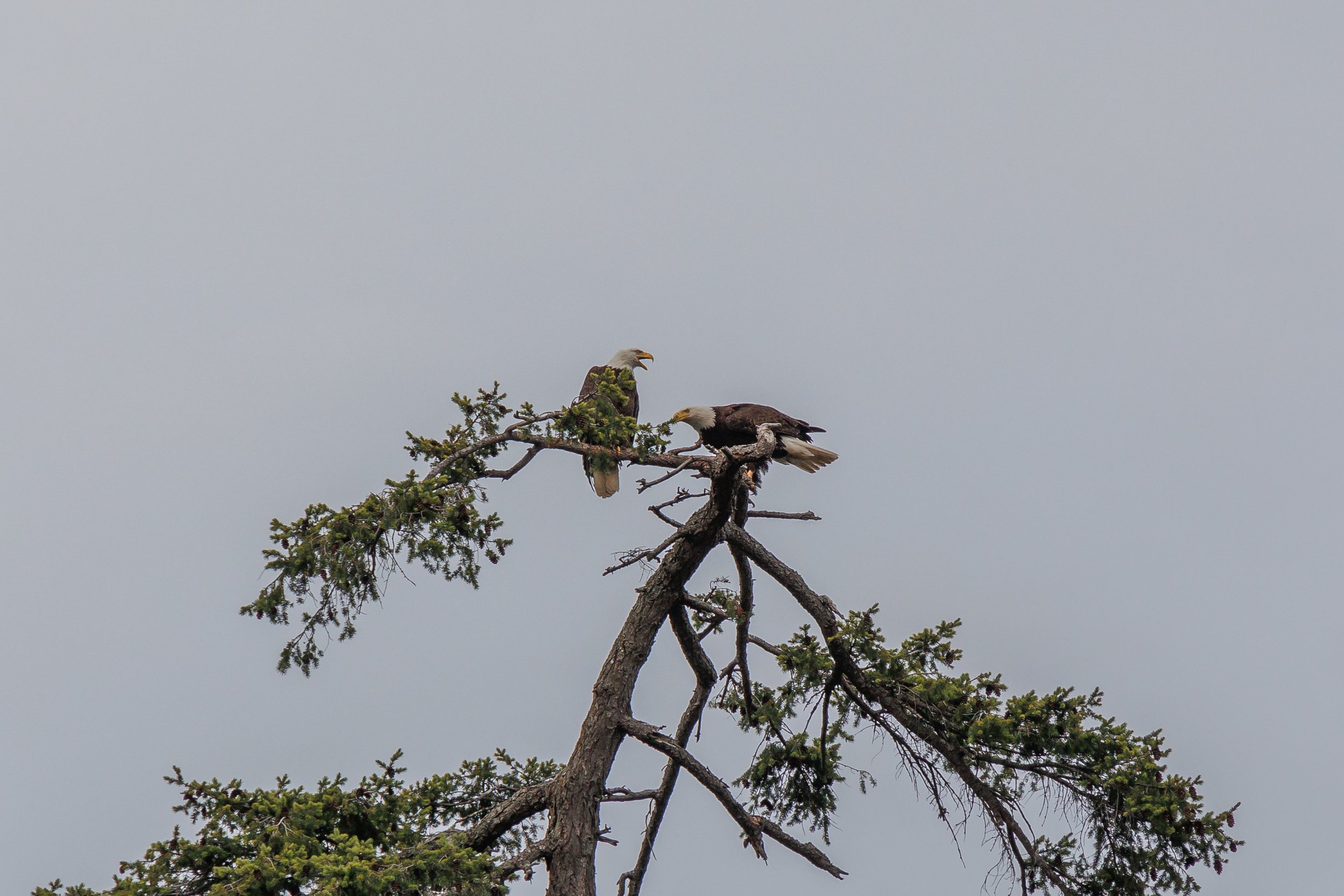June 17, 2023 - T100Bs off Batchelor Cove
This morning our crew headed across the Georgia Strait to Howe Sound to catch up with some reported Orca in the area. It was a bit of a wavy day, but our spirits were high! When we arrived on scene, we identified our Transient Killer Whales as the T100Bs! This smaller group consists of:
T100B Freya ♀ (1997)
T100B1 Seidr (2010)
These two were moving quickly, doing very fast dives and staying down for several minutes at a time. Watching wildlife is always unpredictable, and we feel so lucky every minute we get to spend with them! In between surfaces, guests on board are treated to stories, facts and interesting features of both the animals we are observing and the surrounding landscape. This allows for a deeply educational experience, alongside the wonder of seeing these animals in their natural habitat.
T100B1 Seidr’s gender has yet to be confirmed, but time will soon tell! The easiest way to distinguish gender among orca is through the size and shape of their dorsal. As the whale hits sexual maturity in their early teens, male orca will go through a “sprouting” period, where the dorsal straightens up and begins to grow in size. Though it hasn’t been confirmed, we are watching with a close eye to see if Seidr is confirmed male in the next few years. T100B Seidr is T100B Freya’s only living child, with a previous calf T100B2 Potnia not surviving past their first birthday.
In February, an interesting article highlighting the differences in maternal care between male and female offspring of the Southern Residents was published in Current Biology. Researchers at the University of Exeter and the Centre for Whale Research used multiple decades of data from the fish-eating southern residents to analyze difference of care requirements of Orca mothers. The data suggests that mothers expend extra energy caring for their sons, at the expense of their own reproductive success. The benefit of this extra doting comes with the “boost” in indirect offspring as the male produces offspring that remain in the care of their own mother’s pods, and then provides less competition between the new offspring and the matriarch. Food sharing is a key component of pods, and its believed that mothers will prioritize feeding their sons so they can continue the bloodline, and with less nutrition, the mothers tend to reproduce less often. This trend is not reflected in daughters, with the opposite effects seen, as daughters with offspring in the pod means more mouths to feed within a family unit. The data also suggests that this doesn’t change as the sons age, so the boys are supported long-term by their mothers, even through adulthood. Big mama’s boys! Researchers are keen to see if this data is also reflected in the Biggs orcas, as they do not face the same feeding limitations as the southern residents. Always more research to do!
Once the hour with the whales was up, we headed out to find some pinnipeds, always a favourite among our guests. The Stellar sea lions always put on great show, with the large male surrounded by his haram. We’re right in middle of pupping season with the Harbour seals, so often are treated to seeing the fuzzy babes with their moms. We finished off the day on the western side of Gabriola to see the cormorant colony at the bluffs, and the Bald eagle family with an active nest. All in all, it was a great day to be out in the Salish Sea!
All photos were taken by our naturalists Carmen Murphy and Aly Kohlman.
T100B1 Seidr (2010).
Photo by Carmen Murphy, 10:30 am.
Photo by Carmen Murphy, 10:30 am.
Enjoying the Vancouver skyline!
Photo by Carmen Murphy, 10:30 am.
Photo by Carmen Murphy, 10:30 am.
T100B1 Seidr (2010)
Photo by Carmen Murphy, 10:30 am.
T100B Freya (1997)
Photo by Carmen Murphy, 10:30 am.
T100B1 Seidr (2010)
Photo by Carmen Murphy, 10:30 am.
Photo by Carmen Murphy, 10:30 am.
A large male Stellar Sea Lion with his females and offspring.
Photo by Carmen Murphy, 10:30 am.
Photo by Carmen Murphy, 10:30 am.
A curious Harbour seal pokes his head up to scope us out!
Photo by Carmen Murphy, 10:30 am.
Photo by Carmen Murphy, 10:30 am.
T100B1 Seidr (2010)
Photo by Carmen Murphy, 3:30 pm.
T100B Freya with the beautiful coastline behind
by Aly Kohlman, 3:30 pm.
T100B Freya (1997)
by Aly Kohlman, 3:30 pm.
T100B1 Seidr (2010)
Photo by Carmen Murphy, 3:30 pm.
T100B Seidr pokes their head up with mom T100B Freya close behind.
Photo by Aly Kohlman, 3:30 pm.
Photo by Carmen Murphy, 3:30 pm.
A group of Cormorants sit on their nests at the bluffs.
Photo by Carmen Murphy, 3:30 pm.
A juvenile Pelagic Cormorant swims by. Look at that yellow bill!
Photo by Carmen Murphy, 3:30 pm.
Our proud Bald Eagle parents keep a close eye on their nest.
Photo by Carmen Murphy, 3:30 pm.
Bald Eagle dad takes a moment of rest.
Photo by Carmen Murphy, 3:30 pm.
Photo by Aly Kohlman, 3:30 pm.
Can you spot the two Bald eaglets?
Photo by Carmen Murphy, 3:30 pm.
Captain Tino gives us a cheeky grin on the open boat Keta.
Photo by Aly Kohlman, 3:30 pm.
Photo by Aly Kohlman, 3:30 pm.


























